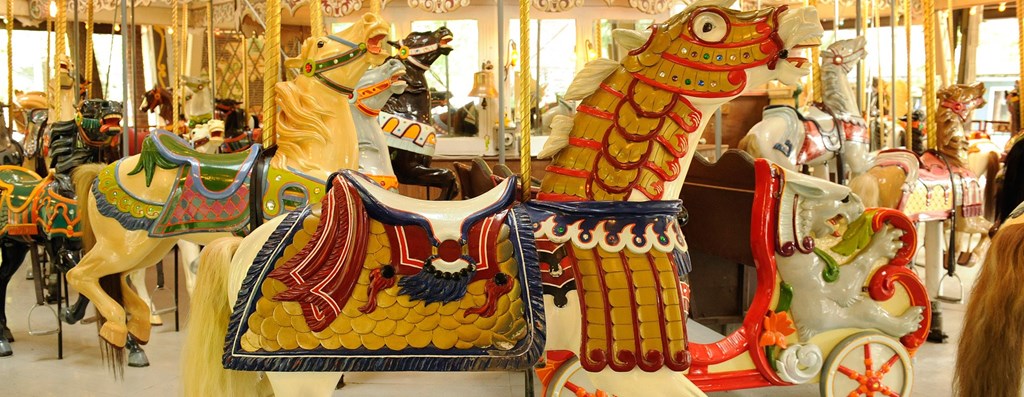
KNOEBELS CAROUSEL & ORGAN HISTORY
As rich as the history of Knoebels itself, our carousel and organ history spans throughout the century and across the globe! From hand-carved figures to paper roll music, each has its own unique features. But there’s one thing that hasn’t changed even after all these years—the joy that comes from riding along to the magical melodies and trying to catch the brass ring for a free ride!
A sample of our carousel history can be found below, but we invite you to join us in person for a tour of the Knoebels Carousel Museum. Then, you can purchase a carousel or horse-themed souvenirs in The Brass Ring gift shop next door. Just use our Interactive Park Map to find your way! We can’t wait to share our story with you!
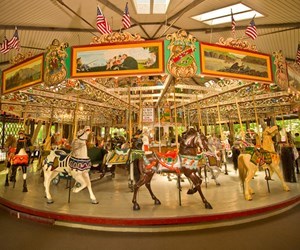
The Grand Carousel
Located in the center of the park. The Knoebels Grand Carousel was built in 1913 at North Beach, Long Island, where it operated with two other machines. The large four-abreast carousel was built by George Kremer, who bought the horses for his older Looff platform from wood-carver Charles Carmel. Carmel was born in Russia in 1865, immigrated to the United States in 1883, and carved carousel figures in his Brooklyn shop until his death in 1931.
Henry Knoebel, the park's founder, purchased the machine in 1941 from Riverside Park in Piscataway Township, New Jersey. Carrying 63 horses and three Looff chariots, the Knoebels Grand Carousel is one of the largest carousels in the world. In fact, it’s one of the few carousels where you can still catch the brass ring for a free ride! Even if all you catch are steel rings, it’s still great fun! In the 17-year history of the internationally acclaimed Golden Ticket Awards, Knoebels Grand Carousel has been voted #1 as the “Best of the Best” in the amusement industry.
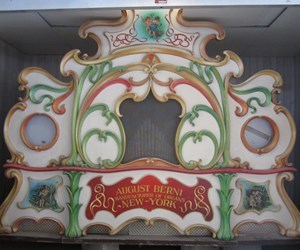
Grand Carousel Organs
The Grand Carousel is accompanied by three organs. The largest was manufactured in 1888 by Frati and Company in Berlin, Germany. It was originally a barrel organ, playing a large pinned cylinder like a music box. In the 1920's it was converted to play the more versatile paper roll system, using 61 key Artizan rolls.
The smaller organ on the outside of the carousel was built in 1910 by the German firm Gebruder Bruder, style 107, and was sold in the USA by the Berni Organ Company of New York. It still plays the original folding cardboard music, available only in Europe. This organ and all its music were extensively damaged during the 1972 flood, when it was in the center of the carousel. Both the organ and music have since been restored.
The third organ is located in the center of the carousel. It is a Wilhem Bruder organ, model 79, and was originally with Philadelphia Toboggan Co. carousel #41, at Ross Farms, Pittsburgh, then Wildwood, NJ. In 1977 that carousel was sold at auction, however, the organ moved to Clementon, NJ, with PTC carousel #49. In 1994 that carousel was also broken up and Knoebels bought the organ. Sometime prior to 1957 it was converted to a Wurlitzer 125 duplex roll system. The organ was restored in 1996.
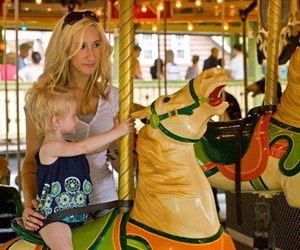
S & G Merry Go Round
Located in Kiddieland. The two-abreast carousel in Kiddieland was carved by the firm of Stein and Goldstein. From their shop in Brooklyn, these two men carved carousel figures from 1910 to 1918. This carousel was purchased by Lawrence Knoebel, son of the park’s founder, in 1948 from Croop's Glen Park in Hunlock Creek, PA. Lawrence operated it for three seasons at nearby fairs and carnivals. It was sold in 1950 to Sunset Beach Park in Harvey's Lake, PA. Later, it was purchased by George Perluke of Beach Haven, PA. Finally, it was purchased back by Knoebels and restored for the 1976 season.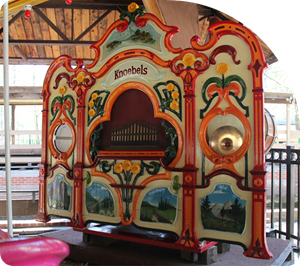
S & G Organ
Adjacent to the S&G Merry Go Round.This organ was originally made by the Bruder Firm in Waldkirch, Germany around 1900. It was converted to play American-made pinned cylinders by Wurlitzer and shipped from their factory April 24, 1914 as a style 18C barrel organ with serial number 2865. It was converted to a duplex paper roll system and shipped by Wurlitzer to Wilkes Barre, PA on May 13, 1925. It first appeared at Knoebels in the late 1920's with the park's first carousel, operated by concessionaire Joseph Gallagher. It went into storage in the 1930's, where it fell victim to vandals, thieves, countless squirrels and rodents. Its façade became the front of a ticket booth in Kiddieland.Restoration began in 1983, and on March 7, 1986, the organ played for the first time in 50 years. A set of bells has been added, and the original 150 duplex roll frame was restored and returned to the organ, as was the façade. It took its place with the S&G carousel in 1988, following the relocation of the carousel from the Spacewalk site to where it is now, in a permanent building.
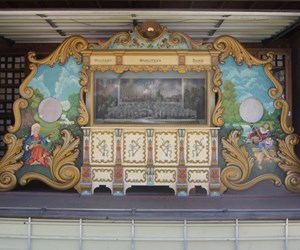
Wurlitzer 165
Located next to the Chalet, across from the Phoenix. This organ was built in 1907 as a style 27 barrel organ by the DeKleist firm in North Tonawanda, NY. It was converted by Wurlitzer in 1914 to play style 165 paper rolls. The organ was purchased by Knoebels in 1948 from Croops's Glen Park in Hunlock Creek, PA. This is the most complex of all the Knoebels organs with many extra percussion effects and automatic stops not found on other organs. It plays 12 hours a day, 7 days a week, whenever Knoebels is open. The library of 165 rolls for this organ is the most complete for any 165 organ.105 Wurlitzer Organ
On display at the bi-annual carousel and organ festival in June. On May 13, 1929, Wurlitzer shipped a style 105 band organ, serial number 4170, to Spillman Engineering Company in North Tonawanda, NY. This was to complete a three abreast carousel sold to Camden Park in Huntington, WV. The carousel and organ remained there until February 8, 1992, when it was auctioned off in Tampa, FL. Knoebels attended the auction, purchasing several horses and the organ, which hadn’t played in years. It was restored in 1995, including new artwork and screen painting. The 105 Wurlitzer plays the original style 125 paper rolls.Tangley Calliaphone
On display at the bi-annual carousel and organ festival in June. Model CA-43, this instrument was built by the Tangley Company of Muscatine, Iowa in the 1920's. It features 43 brass “whistles,” playable from a keyboard or automatically from a type “A” paper roll. This is a typical circus calliope, intended more for use on a parade wagon or midway than on a carousel. The Tangley was purchased by Knoebels on February 13, 1988 at the auction of the final remains of Playland Park in San Antonio, TX. This is the same park which was the original home of the Phoenix Roller Coaster, then known as the Rocket. Of the two Tangleys at the sale, this one was in rougher condition, but was the one used at Playland Park. The calliope was restored in 1989.Wurlitzer Caliola Organ
On display at the bi-annual carousel and organ festival in June. This organ contains 44 wooden flute pipes and is more of a carousel organ than the Tangley. Like the Tangley, it can be played from a keyboard or automatically from a Wurlitzer Caliola roll or an APP roll, used on many Wurlitzer nickelodeons. It is one of only 62 ever made. Serial number 4111, this instrument was originally shipped, complete with a gasoline engine, to Mercersburg, PA on August 15, 1928. The Caliola was completely submerged for several days during the 1972 flood, creating a restoration nightmare. Restoration was finally completed February, 1987.Limonaire Street Organ
On display at the bi-annual carousel and organ festival in June. This organ was purchased in 1996. It is a Limonaire organ of 35 keys, built around 1920 in Holland. A Dutch rebuilder supplied another front for it, and it can now be run by electric motor or by hand with a large wheel. It can be pushed through the park and played at will, cord or not! It plays 35 key folding cardboard music.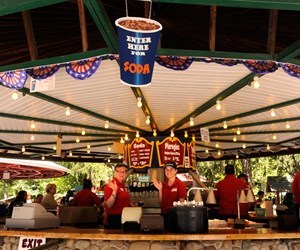
Round Stand
Our Round Stand and covered seating areas were once part of 3 carousels designed by Allan Herschell, and in operation at Kishacoquillas Park in Lewistown, PA. The 1972 flood devastated much of the park, and soon after, the carousels were dismantled and sold. Knoebels was able to purchase a solitaire carousel horse and all three carousel mechanisms. The mechanisms were used as the foundation to create what is now known as the Round Stand Concession and the adjacent covered seating areas. If you look closely at each roof line, you will see them slowly revolve.Carousel Museum
In 1992, Knoebels opened the Carousel Museum, located near the Tilt-A-Whirl. This unique addition to the park features over 50 carousel figures, scenery panels, chariot sides and other memorabilia from carousels dating back to 1870. Whether you want to spend an afternoon learning about carousel history, or need an entertaining break from the rides , this free exhibit has something for everyone.Additional Resources
Carousel Organ Association of America (COAA)
http://www.coaa.us
[email protected]
National Carousel Association
http://www.nca-usa.org